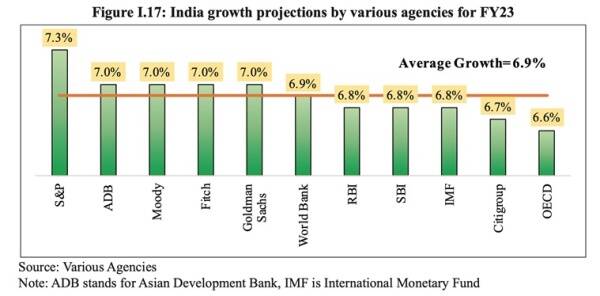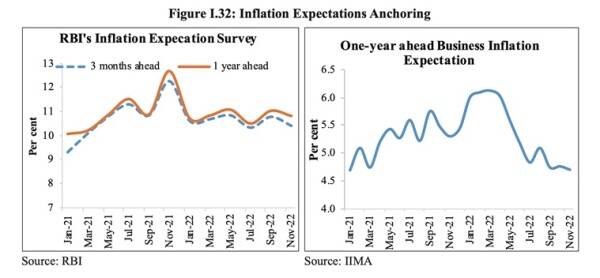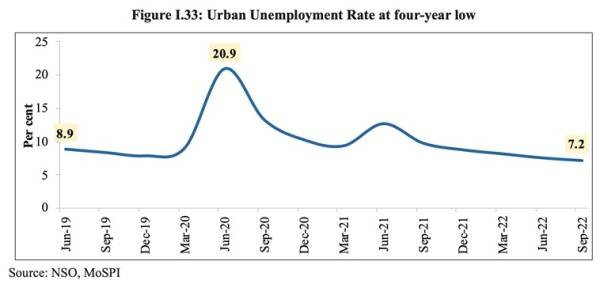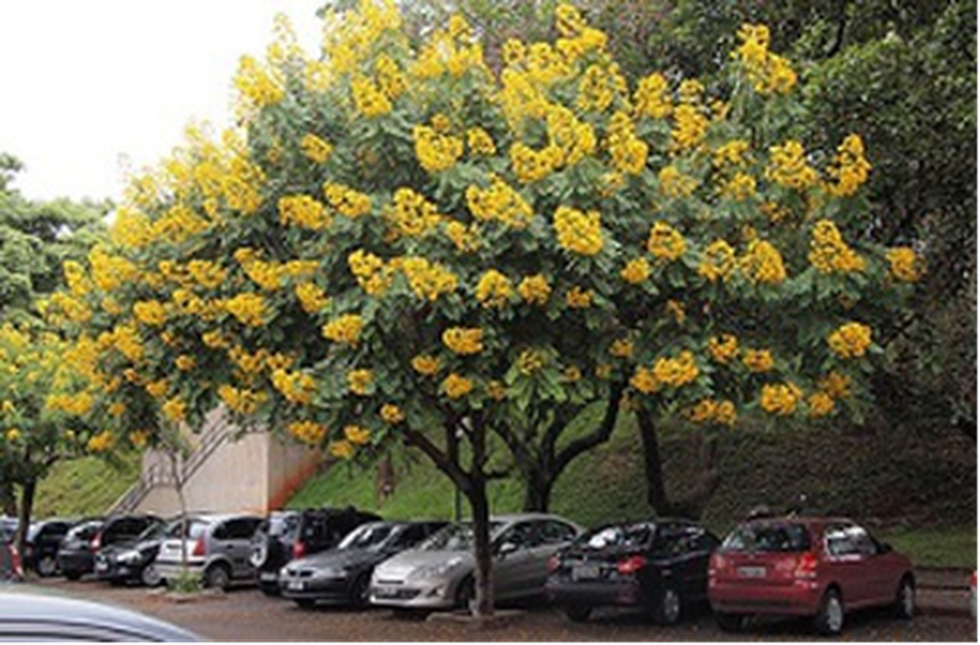CONTENTS
- Economic Survey 2023: Key takeaways
- World Economic Outlook
- Leprosy
- Neglected Tropical Diseases
- Groundwater charges on non-exempted users
- Senna Spectabilis
Economic Survey 2023: Key Takeaways
Context:
Recently, the government tabled the Economic Survey 2022-23. The Survey laid out the outlook for India’s growth, inflation and unemployment in the coming years.
Relevance:
GS III: Indian Economy
Dimensions of the Article:
- What is the Economic Survey?
- What are the main takeaways this year?
- What does it mean for India’s economy?
- What is the reference to 2003?
What is the Economic Survey?
- The Survey provides a detailed report of the national economy for the year along with forecasts. It touches upon everything from agriculture to unemployment to infrastructure.
- It is prepared by the Economic Division of the Department of Economic Affairs (DEA).
- The comments or policy solutions contained in the Survey are not binding on the government.

What are the main takeaways this year?
GDP growth:
- The Survey said India’s growth estimate for FY23 is higher than for almost all major economies.
- “Despite strong global headwinds and tighter domestic monetary policy, if India is still expected to grow between 6.5 and 7.0 per cent, and that too without the advantage of a base effect, it is a reflection of India’s underlying economic resilience; of its ability to recoup, renew and re-energise the growth drivers of the economy,” said the Survey.

Inflation:
- The RBI has projected headline inflation at 6.8% in FY23, outside its comfort zone of 2% to 6%.
- High inflation is seen as one big factor holding back demand among consumers.
- However, the Survey sounded optimistic about the inflation levels and trajectory, saying “it is not high enough to deter private consumption and also not so low as to weaken the inducement to invest.”
Unemployment:
- The Survey said “employment levels have risen in the current financial year”, and that “job creation appears to have moved into a higher orbit with the initial surge in exports, a strong release of the “pent-up” demand, and a swift rollout of the capex.”
- It pointed to the Periodic Labour Force Survey (PLFS), which showed that urban unemployment rate for people aged 15 years and above declined from 9.8% in the quarter ending September 2021 to 7.2% one year later.
- The Survey also underlined that the fall in unemployment rate is accompanied by an improvement in the labour force participation rate.

Outlook for 2023-24
- The Survey projected a baseline GDP growth of 6.5% in real terms in FY24.
- However, it detailed some downside risks.
- For instance, low demand for Indian exports, thanks to poor global growth, may widen India’s trade deficit and make the rupee depreciate. Similarly, sustained monetary tightening (higher interest rates) may drag down economic activity in FY24.
What does it mean for India’s economy?
- The focus of this year’s Survey is that India’s economy has overcome the impact of Covid and is finally set to see strong and sustained growth in the upcoming years.
- According to CEA V Anantha Nageswaran, the period from 2014 to 2022 under the BJP government saw significant structural and governance reforms that improved the economy’s efficiency.
- These reforms did not immediately produce desired results due to banks clearing their non-performing assets and businesses reducing their debt, and were further impacted by the Covid pandemic and the Ukraine war.
- However, as these shocks subside, the Survey predicts that the Indian economy will grow at its full potential, similar to the growth experienced after 2003, making its outlook better than before the pandemic.
What is the reference to 2003?
- The Survey argued that the situation in 2023 is similar to how the economy was poised in 2003.
- It said the period between 2014 and 2022 is analogous to 1998-2002, when despite transformative reforms by the government (also led by the BJP), the Indian economy lagged growth returns.
- This was due to temporary shocks such as the US sanctions after India’s nuclear test, two successive droughts, the collapse of the tech boom, etc.
- But once these shocks faded, the structural reforms paid growth dividends from 2003. The Survey claims the same story is set to repeat from 2023.
How likely is this?
- Before the Covid pandemic, India’s potential growth rate, the rate at which it can grow without causing inflation, had dropped to just 6%. In the 2003-2008 period, it was 8% and 7% between 2009 and 2015, with no expectation of rising above 6% in the near future.
- In contrast to the 2003-2008 period when the global economy was thriving, the current situation is the opposite.
- Unemployment rates in India do not accurately reflect the distress in the labor market as the labor force participation rate is low. Additionally, over the past two decades, India’s growth has become increasingly capital-intensive, which is likely to worsen with the increasing automation of routine jobs.
- Widespread joblessness results in lower incomes and consumer demand, which discourages private sector investments and slows down economic growth.
- India, as the world’s most populous country with a growing youth population and the largest number of poor and malnourished children, requires faster growth than many developed countries to improve its low per capita income. Even though a 6% growth rate should be attainable, it may not generate enough jobs to meet the demands of a growing population. A growth rate of 4% in India can feel like a recession.
-Source: Indian Express
World Economic Outlook
Context:
In its January update of the World Economic Outlook (WEO) report, the IMF has marginally improved the forecast for global growth in 2023 — a relief, given the fears of a global recession in 2023. The turnaround reflects “positive surprises and greater-than-expected resilience in numerous economies”.
Relevance:
GS III: Indian Economy
Dimensions of the Article:
- Key takeaways from the latest update
- World Economic Outlook
- About International Monetary Fund (IMF)
Key takeaways from the latest update:
Global growth will bottom out in 2023
- The IMF previously forecasted that the global growth rate would drop from 3.4% in 2022 to 2.7% in 2023, but has now revised the outlook.
- A global recession is no longer expected by the IMF.
- The global growth rate is projected to hit its lowest point in 2023 before picking up again in 2024.
- The IMF now predicts global growth to be 2.9% in 2023 and 3.1% in 2024.
- Upward revisions in 2023 GDP forecasts have been seen in China, Russia, US, Germany, and Italy.
- The UK saw a significant decrease in its 2023 GDP forecast, almost 1 percentage point.
Global inflation has peaked but relief will be slow
- Global inflation is expected to have peaked in 2022.
- The disinflation (decrease in inflation rate) is expected to be slow and occur throughout 2023 and 2024.
- 84% of countries are expected to have lower headline inflation in 2023 compared to 2022.
- Global inflation is forecast to decrease from 8.8% in 2022 (annual average) to 6.6% in 2023 and 4.3% in 2024, still above the pre-pandemic levels of around 3.5%.
- The slowing of inflation is due to monetary tightening worldwide and decreasing demand for goods and services.
- Advanced economies are expected to have an inflation rate of 4.6% in 2023, while emerging economies will face an inflation rate of 8.1%.
India will stay the world’s fastest growing major economy in 2023 and 2024
- India’s Growth Outlook Remains Unchanged Since October 2022 According to the IMF, India’s growth is projected to decrease from 6.8% in 2022 to 6.1% in 2023 before rebounding to 6.8% in 2024.
- This is due to the resilient domestic demand despite external challenges. As a result, India will remain the fastest-growing major economy in the world both in 2023 and 2024, outpacing other comparable economies such as China (which is expected to grow at 5.4% in 2023 and 4.5% in 2024).
World Economic Outlook
- It is a survey by the IMF that is usually published twice a year in the months of April and October.
- It analyzes and predicts global economic developments during the near and medium term.
- The IMF releases the WEO twice every year, in April and October, apart from updating it twice — in January and July.
About International Monetary Fund (IMF)
- The International Monetary Fund (IMF) is an international organization headquartered in Washington, D.C.
- It consists of 189 countries working to foster global monetary cooperation, secure financial stability, facilitate international trade, promote high employment and sustainable economic growth, and reduce poverty around the world. It periodically depends on the World Bank for its resources.
- Through the fund and other activities such as the gathering of statistics and analysis, surveillance of its members’ economies, and the demand for particular policies, the IMF works to improve the economies of its member countries.
Functions of the IMF
- To provide financial assistance to member countries with balance of payments problems, the IMF lends money to replenish international reserves, stabilize currencies and strengthen conditions for economic growth.
- Countries must embark on structural adjustment policies monitored by the IMF.
- It oversees the international monetary system and monitors the economic and financial policies of its 189 member countries.
- As part of this process, which takes place both at the global level and in individual countries, the IMF highlights possible risks to stability and advises on needed policy adjustments.
- It provides technical assistance and training to central banks, finance ministries, tax authorities, and other economic institutions.
- This helps countries raise public revenues, modernize banking systems, develop strong legal frameworks, improve governance, and enhance the reporting of macroeconomic and financial data.
- It also helps countries to make progress towards the Sustainable Development Goals (SDGs).
-Source: Indian Express
Leprosy
Context:
Every year last Sunday in January is observed as Leprosy Day. This year, it was on 29th January. Leprosy is also known as Hansen’s disease.
Relevance:
GS II- Health
Dimensions of the Article:
- What is Leprosy?
- What are the symptoms?
- How does it spread?
What is Leprosy?
- Leprosy is a chronic, progressive bacterial infection caused by the bacterium Mycobacterium leprae.
- It primarily affects the nerves of the extremities, the skin, the lining of the nose, and the upper respiratory tract.
- Leprosy is also known as Hansen’s disease.
- Hansen’s disease produces skin ulcers, nerve damage, and muscle weakness. If it isn’t treated, it can cause severe disfigurement and significant disability.
- Hansen’s disease is one of the oldest diseases in recorded history. The first known written reference to Hansen’s disease is from around 600 B.C.
- Hansen’s disease is common in many countries, especially those with tropical or subtropical climates.
- It’s not very common in the United States.
- The Centers for Disease Control and Prevention (CDC)Trusted Source reports that only 150 to 250 new cases are diagnosed in the United States each year.
What are the symptoms?
- The main symptoms of Hansen’s disease include:
- muscle weakness
- numbness in the hands, arms, feet, and legs
- skin lesions
- The skin lesions result in decreased sensation to touch, temperature, or pain.
- They don’t heal, even after several weeks.
- They’re lighter than your normal skin tone or they may be reddened from inflammation.
How does it spread?
- The bacterium Mycobacterium leprae causes Hansen’s disease.
- It’s thought that Hansen’s disease spreads through contact with the mucosal secretions of a person with the infection. This usually occurs when a person with Hansen’s disease sneezes or coughs.
- The disease isn’t highly contagious.
- However, close, repeated contact with an untreated person for a longer period of time can lead to contracting Hansen’s disease.
- The bacterium responsible for Hansen’s disease multiplies very slowly. The disease has an average incubation period (the time between infection and the appearance of the first symptoms) of five years, according to the World Health Organization (WHO).
-Source: The Hindu
Neglected Tropical Diseases
Context:
The recent World Health Organization (WHO) report said that Neglected Tropical Diseases (NTD) continue to disproportionately impact the most impoverished members of the international community.
Relevance:
Prelims, GS-III: Science and Technology
Dimensions of the Article:
- What are Neglected Tropical Diseases (NTD)?
- Government’s efforts regarding NTD
- About the World Neglected Tropical Diseases Day declaration
What are Neglected Tropical Diseases (NTD)?
- Neglected tropical diseases (NTDs)– a diverse group of communicable diseases that prevail in tropical and subtropical conditions in 149 countries – affect more than one billion people and cost developing economies billions of dollars every year.
- Populations living in poverty, without adequate sanitation and in close contact with infectious vectors and domestic animals and livestock are those worst affected.
- Seven of the most common NTDs can be found in a number of countries—primarily in low- and middle-income countries of Africa, Asia, and Latin America.
- Controlling the vectors (e.g., mosquitoes, black flies) that transmit these diseases and improving basic water, sanitation, and hygiene are highly effective strategies against these NTDs.
The NTD Crisis
- NTDs such as dengue, lymphatic filariasis and visceral leishmaniasis (Kala-Azar) afflict 1 billion people worldwide, and yet, are not prioritised in the public health narrative in many parts of the world.
- India bears the largest burden of NTDs in the world, accounting for 40 per cent of the global lymphatic filariasis disease burden and almost a quarter of the world’s visceral leishmaniasis cases.
Government’s efforts regarding NTD
- In recent years, the government has made concerted efforts to address the nation’s NTD burden, especially visceral leishmaniasis and lymphatic filariasis which were slated to be eliminated by 2020 and 2021 respectively.
- India has already eliminated several other NTDs, including guinea worm, trachoma, and yaws.
- Measures taken include Mass Drug Administration (MDA) for lymphatic filariasis prevention in endemic districts and Indoor Residual Spraying (IRS) to control the breeding of sandflies that transmit visceral leishmaniasis.
- The Accelerated Plan for Elimination of Lymphatic Filariasis (APELF) was launched in 2018, as part of intensifying efforts towards the elimination of NTDs.
- A WHO-supported regional alliance established by the governments of India, Bangladesh, and Nepal in 2005 to expedite early diagnosis and treatment of the most vulnerable populations and improve disease surveillance and control of sandfly populations (Kala-azar).
About the World Neglected Tropical Diseases Day declaration
- London Declaration on NTDs on 30th January, 2012 recognised the global burden of NTDs.
- Officials from the World Health Organization (WHO), the World Bank, the Bill and Melinda Gates Foundation, representatives from leading global pharmaceutical companies as well as representatives of several national governments met at London’s Royal College of physicians to pledge to end the diseases.
- The ongoing 74th World Health Assembly declared 30th January as ‘World Neglected Tropical Diseases (NTD) Day. The first World NTD Day was celebrated informally in 2020.
-Source: Down to Earth
Groundwater Charges on Non-Exempted Users
Context:
From now onwards, groundwater extraction by industries and other establishments will be metered and charged, and anyone with an existing borewell or anyone digging afresh will have to take permission from Punjab Water Regulation and Development Authority (PWRDA).
Relevance:
GS II: Government Policies and Interventions
Dimensions of the Article:
- What are the latest directions about extraction of underground water?
- Who all would be exempted from paying the bill?
- How would the permission be sought?
- How will the authority bill the users?
- Who would install the meters?
What are the latest directions about extraction of underground water?
- Groundwater extraction by any method or technology is subject to charges by the authority.
- This includes extraction through open wells, dug wells, bore wells, dug-cum-bore wells, tube wells, step wells, filter points, collector wells, artesian wells, springs, infiltration galleries, etc.
- The charges also apply to any machinery, equipment, and instruments used for groundwater extraction.
- The charges are applicable to any combination or variation of structures used for extraction.
Who all would be exempted from paying the bill?
- Farmers using water for agriculture purposes are exempt from the charges.
- Places of worship are exempt from the charges.
- Drinking and domestic water supply schemes of the government are exempt from the charges.
- Establishments of the military or central paramilitary forces are exempt from the charges.
- Urban local bodies, panchayat raj institutions, cantonment boards, improvement trusts, and area development authorities are exempt from the charges.
- Units extracting not more than 300 cubic meters of groundwater per month are exempt from the charges.
Is there any bar on water tankers?
No motor vehicle shall be used for conveyance or transportation of groundwater through a water tanker (whether installed on the vehicle or towed as a trailer etc.) with a carrying capacity in excess of 500 litres for any purpose other than drinking and domestic or agricultural usage without Permission of the Authority.
How would the permission be sought?
- The permission would be required to be taken within six months of notification of the directions.
- Existing units seeking permission for extraction of a volume groundwater (other than brackish/saline water) more than 15,000 cubic metres per month shall submit a chemical analysis report of water of each extraction structure provided by a NABL-accredited laboratory.
- This report should not be older than six months on the date of application.
- New units granted permission to extract more than 15,000 cubic metres per month of groundwater shall provide this report within 6 months of grant of permission.
How will the authority bill the users?
- Groundwater extraction charges shall be paid by the user on a self-assessment basis in accordance with the self-recorded and reported water meter readings.
- In addition, the authority may verify the water meter readings either periodically or at any time.
- Groundwater extraction charges shall be paid on a monthly basis.
- A user shall convey the water meter readings of the last working day of the month to the authority by the 10th day of the ensuing month and shall make payment of the charges by 20th of every month.
Who would install the meters?
- A user requiring permission for groundwater extraction under the directions shall install volumetric water meters on each extraction structure.
- All water meters shall conform to the technical specifications, performance parameters and connectivity standards as required by the authority.
- It shall be the responsibility of the user to ensure that each water meter including the telemetry device (if required) is fully functional and in proper working order at all times.
-Source: Indian Express
Senna Spectabilis
Context:
The Nodal Centre for Biological Invasions (NCBI) at the Kerala Forest Research Institute (KFRI) has recently come out with a management plan to eradicate Senna spectabilis.

Relevance:
Facts for Prelims
Dimensions of the Article:
- Details
- About Senna Spectabilis
- Key facts about the Periyar Tiger Reserve
Details:
- Based on the results of the experimental study done at the Periyar Tiger Reserve, the plan envisages landscape-level management of the tree.
- The two key factors considered in developing the management protocol were the fast nature of the spread of the tree in natural forests, and the restoration of natural forests based on landscape.
About Senna Spectabilis:
- Senna spectabilis is a plant species of the legume family (Fabaceae) native to South and Central America.
- The plant has become an invasive alien species in parts of Africa, India and other countries.
- The thick foliage of the tree arrests the growth of other indigenous tree and grass species.Hence,it causes food shortage for the wildlife population especially herbivores.
- It also adversely affects the germination and growth of the native species.
- It is categorised as ‘Least Concern’ under IUCN Red List.
Key facts about the Periyar Tiger Reserve
- It is nestled in the southern region of Western Ghats in the state of Kerala.
- It is drained by the rivers Mullayar and Periyar.
- Flora: tropical evergreen, semi-evergreen, moist deciduous forests and grasslands.
- Fauna: Tiger, Elephant, Lion-tailed macaque, Nilgiri Tahr etc.
-Source: The Hindu




